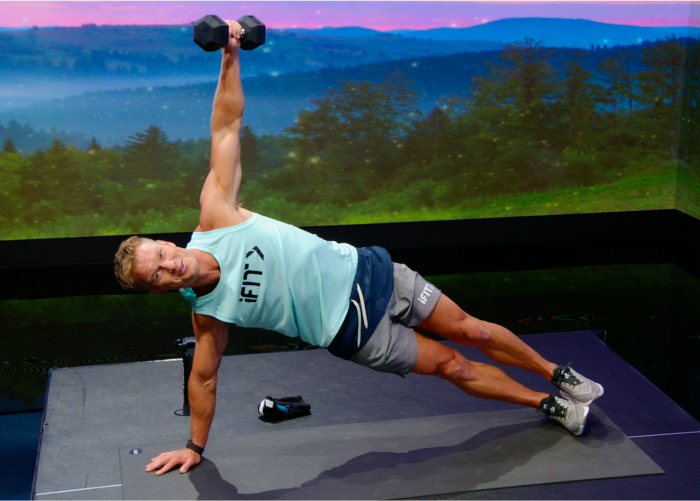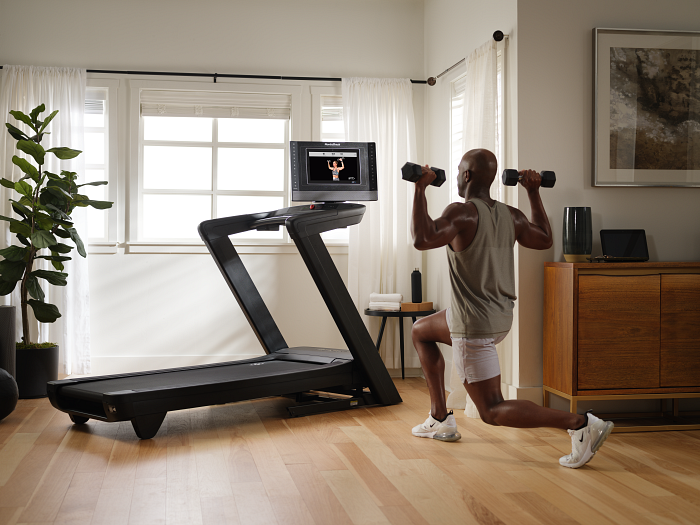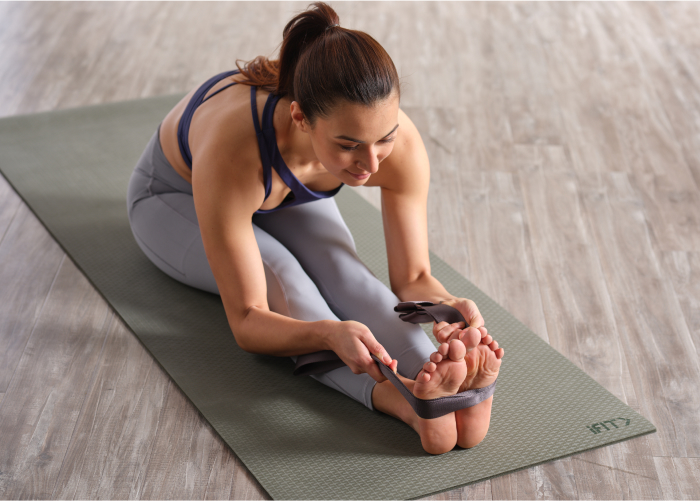
What if we told you that achieving your fitness goals is a lot like planning a road trip? Suppose you are at Point A – your starting location, and your destination is Point B – your fitness objectives. To reach your destination smoothly, you need a roadmap.
That’s exactly why having a workout program is essential—it serves as your fitness roadmap!
Still unsure about the importance of a workout program? Allow us to show you seven compelling reasons to follow a workout program.

What is a fitness plan?
Before we delve further into the benefits of having a workout plan, it’s important to understand what is a fitness plan.
A fitness plan, also known as a workout program, is a detailed roadmap designed to guide an individual’s physical exercise routine. [1]
It’s not a random collection of exercises, but a carefully crafted guide that considers various factors such as the person’s current fitness level, personal goals, health conditions, and available resources.
There are various types of fitness plans, including those geared towards weight loss, muscle gain, cardiovascular health improvement, enhanced endurance, or a combination of these. Each plan incorporates a variety of exercises targeting different areas of fitness and outlines the frequency, intensity, type, and time of each workout.
A comprehensive fitness plan typically integrates the 4 key components of fitness: cardiorespiratory endurance (aerobic exercise), muscular strength (resistance training), muscular endurance (resistance training), and flexibility (stretching exercises). [2]
The beauty of a fitness plan is that it can be tailored to meet individual goals and needs, providing a personal, adaptable approach to fitness. So whether you’re a newbie looking to get started, or an experienced athlete looking to boost your performance, a fitness plan can be your stepping stone to success. [3]
Now that we’ve gotten the “what” out of the way, let’s look at:
7 reasons to follow a workout program instead of winging it
Here’s why it pays to use a workout program as your guide instead of using random workouts here and there:

1. Creates a ‘roadmap’ to success
As we mentioned at the start of this article, one of the primary reasons to follow a workout program is that it provides a roadmap to fitness success. [4] But why? And how?
Well, random workouts without a plan might feel productive, but they may result in inefficient training. A well-crafted fitness plan offers a comprehensive guide, outlining the exercises to do, the rest periods, sets and repetitions, and the progression for each exercise.
This way, your journey from point A (where you are) to point B (where you want to be fitness-wise) becomes less daunting and more efficient. [5]

2. Introduces progressive overload
When asking, “Why is it important to follow a workout program?” or “Is it better to follow a workout program?” science can help answer those pressing questions.
Why you need a fitness plan is well explained by the principle of progressive overload—one of the key benefits of having a workout plan. [6] This concept refers to the systematic increase of stress on your body during exercise, which results in steady improvement over time. [7]
Unlike haphazardly trying new workouts, which could lead to uneven or slow progression, a structured fitness plan ensures that your body is consistently challenged. In turn, this may lead to more sustainable and noticeable improvements in your fitness. [8]

3. Challenges new muscle groups
Another compelling reason to follow a workout program is its balanced approach to muscle engagement.
Simply put, a fitness plan helps ensure that every part of your body gets the workout it needs. [9]
It builds on exercises you’re familiar with and gradually introduces new moves to challenge different muscles, boosting your overall strength and fitness. [10]

4. Offers a fresh and exciting fitness journey
“Is it better to follow a workout program?” you may be wondering. Absolutely! A structured workout program brings variety, making your fitness journey interesting and exciting.
By alternating between different types of workouts—like cardio, strength training, and flexibility exercises—your workout plan helps stave off boredom and keep you motivated. [11]

5. Embraces the ‘Four Pillars of Fitness’
One of the most significant benefits of a fitness plan is its comprehensive nature. A well-rounded workout program incorporates the 4 key components of a fitness plan: cardiorespiratory endurance, muscular strength, muscular endurance, and flexibility. [12]
Each component plays a vital role in promoting overall health and well-being. Without a workout program, you might inadvertently neglect one or more of these essential components, leading to imbalanced fitness levels.[13]

6. Establishes healthy habits
Another crucial aspect of why it’s essential to have a fitness plan is the role it plays in establishing and reinforcing healthy habits. [14]
Consistent exercise is a critical component of a healthy lifestyle, but without a plan, it can be easy to neglect or postpone workouts.
A well-crafted workout program sets a structure and holds you accountable, helping to make exercise a regular part of your routine. [15] This consistency not only aids in reaching your fitness goals but also contributes to overall physical health, mental well-being, and the reduction of certain health risks. [16]
7. Promotes personalization and adaptability
Last but not least, on our list of reasons to follow a workout program is its adaptability to individual needs and goals.
Every person’s body, fitness levels, and objectives are different. Hence, a ‘one-size-fits-all’ approach to fitness isn’t always effective.
A good workout program is personalized, considering your current fitness level, potential health concerns, and specific goals (like weight loss, muscle gain, or improved endurance).
As your fitness improves over time, the plan can be adapted to ensure you’re continually progressing and meeting your evolving fitness goals. [17]
The bottom line
There you have it: seven compelling reasons why you need a fitness plan. So, is it important to have a fitness plan? It certainly is! Whether you’re asking, “What are the benefits of a fitness plan?” or “Why is it important to follow a workout program?” the reasons are clear: a well-structured workout program is your roadmap to fitness success.
It offers progressive challenges, ensures balanced muscle engagement, keeps your workout routine fresh, and encompasses all the key aspects of fitness.
So, start planning, and let the gains begin!
Start a workout program with iFIT!
iFIT, a paid subscription fitness platform, offers thousands of on-demand workouts led by expert trainers, including series designed to help you start – and stick to – a workout program. Check out these beginner series, available on iFIT-enabled NordicTrack equipment.
Treadmill
Bike
Rower
- Total-Body Transformation: Phase 1 with Toby Massenburg
- Power HIIT and Core: Phase 1 with Casey Gilbert
Strength & Yoga
Footnotes
- Thompson, W.R. (2010). Worldwide Survey of Fitness Trends for 2011. ACSM’s Health & Fitness Journal, 14(6), 8-17. doi: 10.1249/FIT.0b013e3181f8b7e8.
- Garber, C.E., Blissmer, B., Deschenes, M.R., Franklin, B.A., Lamonte, M.J., Lee, I., Nieman, D.C., & Swain, D.P. (2011). Quantity and Quality of Exercise for Developing and Maintaining Cardiorespiratory, Musculoskeletal, and Neuromotor Fitness in Apparently Healthy Adults: Guidance for Prescribing Exercise. Medicine & Science in Sports & Exercise, 43(7), 1334-1359. doi: 10.1249/MSS.0b013e318213fefb.
- Ratamess, N.A., Alvar, B.A., Evetoch, T.K., Housh, T.J., Kibler, W.B., & Kraemer, W.J. (2009). Progression Models in Resistance Training for Healthy Adults. Medicine & Science in Sports & Exercise, 41(3), 687-708. doi: 10.1249/MSS.0b013e3181915670.
- Donnelly, J.E., Blair, S.N., Jakicic, J.M., Manore, M.M., Rankin, J.W., & Smith, B.K. (2009). Appropriate Physical Activity Intervention Strategies for Weight Loss and Prevention of Weight Regain for Adults. Medicine & Science in Sports & Exercise, 41(2), 459-471. doi: 10.1249/MSS.0b013e3181949333.
- Garber, C.E., Blissmer, B., Deschenes, M.R., Franklin, B.A., Lamonte, M.J., Lee, I., Nieman, D.C., & Swain, D.P. (2011). Quantity and Quality of Exercise for Developing and Maintaining Cardiorespiratory, Musculoskeletal, and Neuromotor Fitness in Apparently Healthy Adults: Guidance for Prescribing Exercise. Medicine & Science in Sports & Exercise, 43(7), 1334-1359. doi: 10.1249/MSS.0b013e318213fefb.
- Kraemer, W.J., & Ratamess, N.A. (2004). Fundamentals of Resistance Training: Progression and Exercise Prescription. Medicine & Science in Sports & Exercise, 36(4), 674-688. doi: 10.1249/01.MSS.0000121945.36635.61.
- Schoenfeld, B.J. (2010). The Mechanisms of Muscle Hypertrophy and Their Application to Resistance Training. Journal of Strength and Conditioning Research, 24(10), 2857-2872. doi: 10.1519/JSC.0b013e3181e840f3.
- Rhea, M.R., Alvar, B.A., Burkett, L.N., & Ball, S.D. (2003). A Meta-Analysis to Determine the Dose Response for Strength Development. Medicine & Science in Sports & Exercise, 35(3), 456-464. doi: 10.1249/01.MSS.0000053727.63505.D4.
- Schoenfeld, B.J., Ogborn, D., & Krieger, J.W. (2016). Effects of Resistance Training Frequency on Measures of Muscle Hypertrophy: A Systematic Review and Meta-Analysis. Sports Medicine, 46(11), 1689-1697. doi: 10.1007/s40279-016-0543-8.
- Ratamess, N.A., Alvar, B.A., Evetoch, T.K., Housh, T.J., Kibler, W.B., & Kraemer, W.J. (2009). Progression Models in Resistance Training for Healthy Adults. Medicine & Science in Sports & Exercise, 41(3), 687-708. doi: 10.1249/MSS.0b013e3181915670.
- Kilpatrick, M.W., Hebert, E., & Bartholomew, J. (2005). College Students’ Motivation for Physical Activity: Differentiating Men’s and Women’s Motives for Sport Participation and Exercise. Journal of American College Health, 54(2), 87-94. doi: 10.3200/JACH.54.2.87-94.
- Pescatello, L.S., Arena, R., Riebe, D., & Thompson, P.D. (2014). ACSM’s Guidelines for Exercise Testing and Prescription. Lippincott Williams & Wilkins.
- Thompson, W.R. (2010). Worldwide Survey of Fitness Trends for 2011. ACSM’s Health & Fitness Journal, 14(6), 8-17. doi: 10.1249/FIT.0b013e3181f8b7e8.
- Lally, P., Van Jaarsveld, C.H.M., Potts, H.W.W., & Wardle, J. (2010). How are habits formed: Modelling habit formation in the real world. European Journal of Social Psychology, 40(6), 998-1009. doi: 10.1002/ejsp.674.
- Conroy, D.E., Elavsky, S., Hyde, A.L., & Doerksen, S.E. (2011). The dynamic nature of physical activity intentions: A within-person perspective on intention-behavior coupling. Journal of Sport & Exercise Psychology, 33(6), 807-827. doi: 10.1123/jsep.33.6.807.
- Warburton, D.E.R., Nicol, C.W., & Bredin, S.S.D. (2006). Health benefits of physical activity: the evidence. Canadian Medical Association Journal, 174(6), 801-809. doi: 10.1503/cmaj.051351.
- Ratamess, N.A., Alvar, B.A., Evetoch, T.K., Housh, T.J., Kibler, W.B., & Kraemer, W.J. (2009). Progression Models in Resistance Training for Healthy Adults. Medicine & Science in Sports & Exercise, 41(3), 687-708. doi: 10.1249/MSS.0b013e3181915670.
Disclaimer: This blog post is not intended to replace the advice of a medical professional. The above information should not be used to diagnose, treat, or prevent any disease or medical condition. Please consult your doctor before making any changes to your diet, sleep methods, daily activity, or fitness routine. iFIT assumes no responsibility for any personal injury or damage sustained by any recommendations, opinions, or advice given in this article. Always follow the safety precautions included in the owner’s manual of your fitness equipment.


